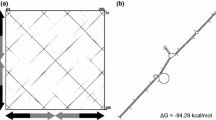Summary
The nivea locus of Antirrhinum majus encodes the enzyme chalcone synthase required for the synthesis of red anthocyanin pigment. The stable allele niv-44 contains an insertion in the nivea gene (Tam2) which has all the structural features of a transposable element. We have shown that this insertion can excise from the nivea locus when niv-44 is combined with another allele (niv-99) in a heterozygote. Activation of Tam2 excision is caused by a factor tightly linked to the niv-99 allele and may be due to complementation between Tam2 and a related element, Tam1. Factors which repress the excision of Tam2 and Tam1 are also described. Repression is not inherited in a simple mendelian way. Many stable mutations may be due to the insertion of transposable elements. Our data suggest that their stability may be due to the absence in the genome of activating factors and to the presence of repressors.
Similar content being viewed by others
References
Bonas U, Sommer H, Saedler H (1984) The 17 kb Tam1 element of Antirrhinum majus induces a 3 bp duplication upon integration into the chalcone synthase gene. EMBO J 3:1015–1019
Carpenter R, Coen ES, Hudson AD, Martin CR (1984) Transposable genetic elements and genetic instability in Antirrhinum. Seventy-third annual report of the John Innes Institute. pp 52–64
Chandler VI, Walbot V (1986) DNA modification of a maize transposable element correlates with a loss of activity. Proc Natl Acad Sci USA 83:1767–1771
Coen ES, Carpenter R, Martin C (1986) Transposable elements genecrate novel spatial patterns of gene expression in Antirrhinum majus. Cell 47:285–296
Döring HP, Starlinger P (1984) Barbara McClintock's controlling elements: now at the DNA level. Cell 39:253–259
Engels WR (1983) The P family of transposable elements in Drosophila. Annu Rev Genet 7:315–344
Harrison BJ, Carpenter R (1973) A comparison of the instabilities at the nivea and pallida loci in Antirrhinum majus. Heredity 31:309–323
Harrison BJ, Stickland RG (1974) Precursors and the genetic control of pigmentation. 2: Genotype analysis of pigment controlling genes in A. majus. Heredity 33:112–115
Hehl R, Sommer H, Saedler H (1987) Interaction between the Tam1 and Tam2 transposable elements of Antirrhinum majus. Mol Gen Genet 207:47–53
Nevers P, Shepherd NS, Saedler H (1986) Plant transposable elements. Adv Bot Res 12:103–203
Rhoades MM (1941) The genetic control of mutability in maize. Cold Spring Harbor Symp Quant Biol 3:138–144
Sanger F, Nicklen S, Coulson AR (1977) DNA sequencing with chain terminating inhibitors. Proc Natl Acad Sci USA 74:5463–5467
Sommer H, Carpenter R, Harrison BJ, Saedler H (1985) The transposable element, Tam3 of Antirrhinum majus generates a novel type of sequence alteration upon excision. Mol Gen Genet 199:225–231
Sommer H, Saedler H (1986) Structure of the chalcone synthase gene of Antirrhinum majus. Mol Gen Genet 202:429–434
Southern E (1975) Detection of specific sequences among DNA fragments separated by gel electrophoresis. J Mol Biol 98:503–517
Spribille R, Forkmann G (1982) Genetic control of chalcone synthase activity in flowers of Antirrhinum majus. Phytochemistry 21:2231–2234
Stickland RG, Harrison BJ (1974) Precursors and genetic control of pigmentation. 1: Induced biosynthesis of pelargonidin, cyanidin and delphinidin in Antirrhinum majus. Heredity 33:108–112
Upadhyaya KC, Sommer H, Krebbers E, Saedler H (1985) The paramutagenic line niv-44 has a 5.7 kb insert, Tam2, in the chalcone synthase gene of Antirrhinum majus. Mol Gen Genet 199:201–206
Vodkin LO, Rhoades PR, Goldberg RB (1983) A lectin gene insertion has the structural features of a transposable element. Cell 34:1023–1031
Wahl GM, Stern M, Stark GR (1979) Efficient transfer of large DNA fragments from agarose gels to diazobenzyloxymethyl paper and rapid hybridisation using dextran sulphate. Proc Natl Acd Sci USA 76:3683–3687
Wienand U, Sommer H, Schwarz ZS, Shepherd N, Saedler H, Kreuzaler F, Ragg H, Fautz E, Hahlbrock R, Harrison BJ, Peterson PA (1984) A general method to identify plant structural genes among genomic DNA clones using transposable element-induced mutations. Mol Gen Genet 187:195–210
Yamamoto KR, Alberts BM, Benzinger R, Lawhorne L, Treiber G (1970) Rapid bacteriophage sedimentation in the presence of polyethylene glycol and its application to large scale virus purification. Virology 40:734–744
Author information
Authors and Affiliations
Additional information
Communicated by J. Schell
Rights and permissions
About this article
Cite this article
Hudson, A., Carpenter, R. & Coen, E.S. De novo activation of the transposable element Tam2 of Antirrhinum majus . Mol Gen Genet 207, 54–59 (1987). https://doi.org/10.1007/BF00331490
Received:
Issue Date:
DOI: https://doi.org/10.1007/BF00331490




